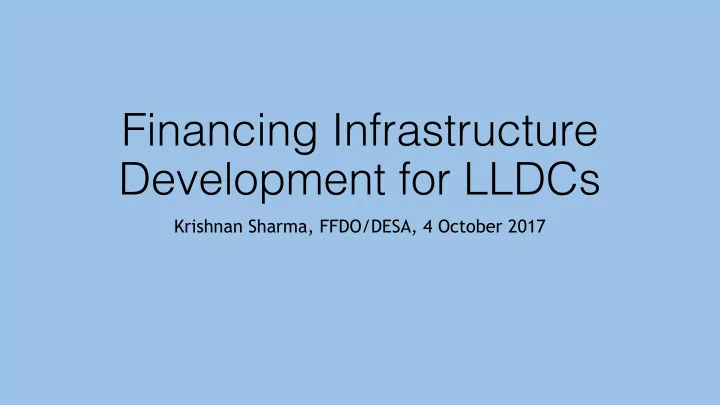

Financing Infrastructure Development for LLDCs Krishnan Sharma, FFDO/DESA, 4 October 2017
Overview of infrastructure financing needs • Estimated infrastructure finance gap of $1 to 1.5 trillion annually in developing countries (Addis Ababa Action Agenda). Global gap estimated at $3 to 5n trillion. • LLDC have unique needs in areas relating to transportation and transit corridors (e.g. roads, rail, airports, pipelines). But they also have broader infrastructure needs similar to other developing countries. • LLDC needs can be interdependent with those of neighbours and the surrounding region. • Illustration of sample LLDC: Zambia.
Estimated infrastructure needs globally (% of total) Source: McKinsey (2016)
Source: G20 Development Working Group, 2014
Infrastructure financing needs assessment by source in Zambia, 2011-2016 Source: Zambia Development Agency (2014). Infrastructure Sector Profile. Available from http:// www.zda.org.zm/?q=content/infrastructure
Options for Financing Infrastructure in LLDCs 1. National Public Finance 2. International Public Finance 3. Private Finance 4. Blending, partnerships and other initiatives
Key issues pertaining to enhancing public finance for infrastructure ❖ Creating fiscal space ❖ Enhancing development cooperation ❖ Utilizing potential of development banks ❖ Tap into recent international and regional initiatives (e.g. GIF , G20 initiative, AIIB, NDB)
Private Finance for Infrastructure ❖ Project side impediments ❖ Financing impediments
Private Participation in Infrastructure, by Country Group (USD billion by year of investment) (Energy, ICT, Transport, Water and Sewerage) Source: World Bank PPI Database
Public Private Partnerships • Inconclusive evidence on performance of PPPs, especially pertaining to development impact, and paucity of studies in developing countries. • Research findings to date indicate that PPPs are better suited for economic infrastructures such as transport and electricity. They are however less likely to deliver efficiency gains in the social sector such as hospitals and schools. • Even in more ‘viable’ sectors, efficacy of PPPs is dependent upon institutional capacity of countries to effectively create, manage and evaluate them.
Institutional Framework for PPPs Source: KS Jomo, Anis Chowdhury, Krishnan Sharma and Daniel Platz (2016). PPPs and the 2030 Agenda for Sustainable Development: Fit for Purpose? UN DESA Working Paper 148.
Overall ▪ Explore effective use of all sources of finance: national public, international public, and various private sources ▪ Countries need to decide on appropriate composition of public and private finance depending on the concerned sectors and their ability to attract the latter ▪ Blended finance and PPPs can be useful but need to be employed with discretion ▪ Importance of utilizing international and regional initiatives
Recommend
More recommend